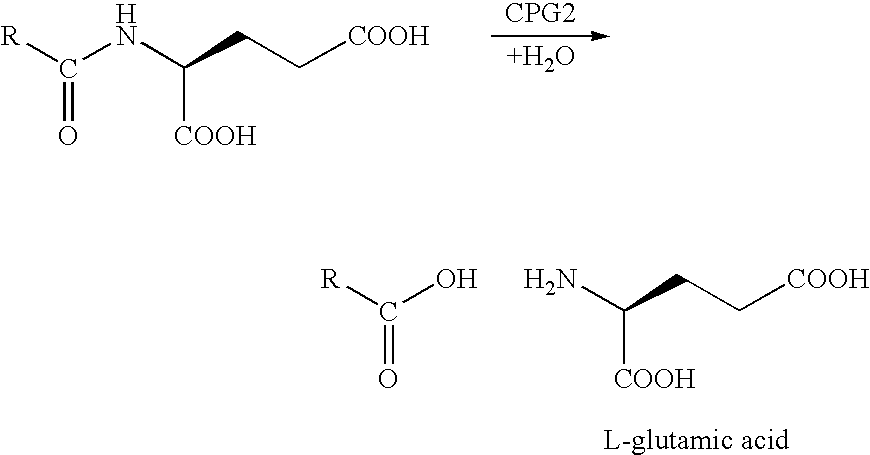Enzyme activated self-immolative n-substituted nitrogen mustard prodrugs
a self-immolative, nitrogen mustard technology, applied in the field of chemotherapy, can solve the problems of limited chemotherapy treatment, unable to administer repeated doses of ab-enzyme conjugates, and killing all tumour cells, so as to inhibit the cell cycle progression of cells and promote apoptosis of cells
- Summary
- Abstract
- Description
- Claims
- Application Information
AI Technical Summary
Benefits of technology
Problems solved by technology
Method used
Image
Examples
specific embodiments
[0258]In one embodiment, the compound is selected from the following compounds, and pharmaceutically acceptable salts, solvates, amides, and esters thereof:
[0259]
[0260]In one embodiment, the compound is selected from P-1, P-2, and P-3, and pharmaceutically acceptable salts, solvates, amides, and esters thereof.
[0261]In one embodiment, the compound is selected from P-1 and pharmaceutically acceptable salts, solvates, amides, and esters thereof.
[0262]In one embodiment, the compound is selected from P-2 and pharmaceutically acceptable salts, solvates, amides, and esters thereof.
[0263]In one embodiment, the compound is selected from P-3 and pharmaceutically acceptable salts, solvates, amides, and esters thereof.
Chemical Terms
[0264]The term “carbo,”“carbyl,”“hydrocarbon” and “hydrocarbyl,” as used herein, pertain to compounds and / or groups which have only carbon and hydrogen atoms (but see “carbocyclic” below).
[0265]The term “hetero,” as used herein, pertains to compounds and / or groups w...
example 1
4-nitro-[bis(2′-hydroxyethyl)]-aniline (X-3a)
[0528]
[0529]4-Nitrofluorobenzene (16.5 g, 11.7 mmol) was mixed with diethanolamine (35 mL) and the mixture was heated at 130° C. and stirred for 16 h. The reaction mixture was cooled to 60° C., then poured into a beaker containing NaOH (6 g) in water (1 L). The yellow precipitate was recovered by filtration and dried in dessicator for 24 h over P2O5, to afford the title compound (22 g, 83%) as a yellow solid.
[0530]1H-NMR δH (ppm) 3.52–3.64 (m, 8H, N(CH2, CH2)2OH), 4.82 (t, 2H, OH, J=5.29 Hz), 6.82 (d, 2H, Harom2+6, J=9.58 Hz), 8.01 (d, 2H, Harom3+5).
example 2
4-Nitro-bis[2′-(tert-butyldimethylsilyloxy)ethyl]-aniline (X-4a)
[0531]
[0532]4-Nitro-[bis(2′-hydroxyethyl)]-aniline (X-3a) (5.0 g, 22.1 mmol) and tert-butyldimethylsilyl chloride (7.5 g, 50 mmol) were dissolved in 20 mL DMF; imidazole (4.76 g, 70 mmol) was added, and the solution stirred at room temperature for 20 h. The solution was then concentrated and purified by column chromatography (cyclohexane:AcOEt 1:1) to afford the title compound (8.9 g, 89%) as an yellow oil.
[0533]1H-NMR δH (ppm): −0.03 (s, 12H, Si—CH3), 0.81 (s, 18H, Si-t-Bu), 3.64 (t, 4H, NCH2, J=5.19 Hz), 3.78 (t, 4H, CH2OSi), 6.83 (d, 2H, Harom2+6, J=9.37 Hz), 8.00 (d, 2H, Harom3+5); MS m / z: 455 (M++1, 88), 477 (M++23, 5), 439 (M+-Me, 53), 397 (M+−t-Bu, 30); acc. mass: (C22H43N2O4Si2) calcd. 455.2761, found 455.2767. Anal. (C22H43N2O4Si2) C, H, N.
PUM
| Property | Measurement | Unit |
|---|---|---|
| particle size | aaaaa | aaaaa |
| concentration | aaaaa | aaaaa |
| concentration | aaaaa | aaaaa |
Abstract
Description
Claims
Application Information
 Login to View More
Login to View More - R&D
- Intellectual Property
- Life Sciences
- Materials
- Tech Scout
- Unparalleled Data Quality
- Higher Quality Content
- 60% Fewer Hallucinations
Browse by: Latest US Patents, China's latest patents, Technical Efficacy Thesaurus, Application Domain, Technology Topic, Popular Technical Reports.
© 2025 PatSnap. All rights reserved.Legal|Privacy policy|Modern Slavery Act Transparency Statement|Sitemap|About US| Contact US: help@patsnap.com



